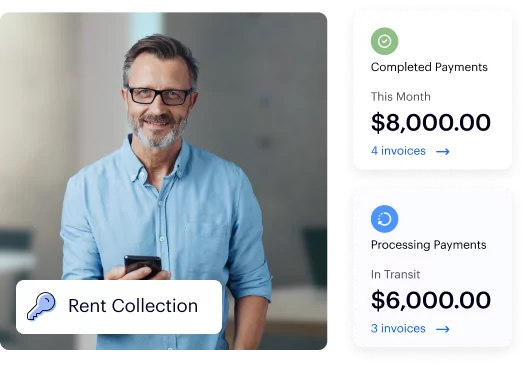Whether you’re a seasoned property owner or just starting, understanding what a rent roll is and how to create one is key to optimizing your rental property’s performance.
This guide covers everything you need to know about rent rolls, including how to create one, its benefits, and a free rent roll sample to help you get started.
Key Takeaways
- A rent roll is a document showing the gross rental income from a property, listing tenant details, rental rates, lease terms, and payment statuses.
- Rent rolls help landlords and property managers track cash flow, reduce vacancies, and manage lease renewals.
- They are essential for investors evaluating property performance and lenders assessing rental property loans.
- Download a free rent roll template to get started or automate the process with Baselane’s all-in-one rent collection, banking, and bookkeeping platform.
Put Rent Collection on Autopilot
Get paid on time with automated rent payments, reminders, and late fees.
What is a rent roll report?
A rent roll is a financial document that shows the gross rental income generated from an investment property. Unlike a rent ledger or lease ledger, a rent roll doesn’t account for expenses such as mortgages, taxes, insurance, and utilities.
Here’s what a rent roll shows:
- Property details: Identifies the owner or management company, address, and property type.
- Tenant information: Includes their names and contact details.
- Unit details: Indicates occupancy, unit number, square footage, and other features.
- Lease details: Records lease terms, renewal date, monthly rent, security deposit, and other fees.
- Payment status: Lists past, current, and scheduled rent payments for each unit, including on-time, overdue, or unpaid rent (Get tips for how to collect unpaid rent)
Who uses rent rolls?
Rent rolls are a versatile tool used by various stakeholders in real estate:
- Landlords: For managing tenant details, rent payments, and lease terms.
- Property Managers: To streamline operations, track occupancy, and reduce manual administrative tasks.
- Investors: To evaluate a property’s performance and make informed acquisition decisions.
- Lenders: To calculate net operating income (NOI) and assess debt service coverage ratio for rental property loan applications.
- Tax Professionals: For ensuring accurate reporting and compliance with tax laws.
How is a rent roll used by potential buyers?
Rent rolls are a critical tool for potential buyers evaluating a rental property’s value and income potential. By reviewing a detailed rent roll, buyers can:
- Assess current occupancy rates and identify vacant units.
- Verify the stability of rental income through tenant payment histories.
- Identify opportunities to increase rental income by adjusting below-market rents.
- Evaluate lease terms and renewal schedules to estimate future cash flow.
A well-maintained rent roll can increase buyer confidence and potentially lead to higher offers during a sale.
How is a rent roll useful to a property manager or landlord?
Rent rolls are critical for streamlining operations and reducing manual tracking. By consolidating tenant data, property managers and landlords can:
- Track lease expirations to minimize vacancies.
- Identify late rent payments and take timely action.
- Analyze rental income trends and forecast cash flow.
- Simplify compliance with tax and legal requirements.
- Plan for property improvements or rent adjustments based on tenant turnover data.
With these insights, property managers and landlords can make more informed decisions to maximize profitability.
Why is a rent roll important to lenders?
Lenders rely on rent rolls to assess the financial health of a property and determine its eligibility for financing. A comprehensive rent roll helps lenders:
- Verify the property’s income stability to assess repayment risk.
- Calculate the debt service coverage ratio (DSCR) to ensure sufficient income to cover loan payments.
- Evaluate tenant payment reliability and lease terms for long-term viability.
A detailed rent roll can improve your chances of securing a favorable loan by demonstrating the property’s strong income potential.
How do rent rolls work?
Rent rolls function as a centralized document that consolidates critical rental property data, providing a clear snapshot of income and tenant activity.
Rent roll data usually comes from a few sources:
- Lease agreements: Rent amounts, tenant details, and lease terms.
- Payment records: Rent paid, late fees, and outstanding balances.
- Property tax assessments: Data on lot size, zoning, and other property characteristics.
- Financial reports: Profit and loss statements for annual and monthly gross income.
- Multiple listing service: Property details from local MLS databases used by real estate agents.
By gathering these details, a rent roll provides actionable insights into the financial performance and operational status of a rental property. Here’s how they work:
- Data aggregation: Rent rolls collect and organize information about tenants, lease terms, rent payments, and unit details in a single document.
- Income tracking: They summarize monthly and annual income from rental units for monitoring revenue streams and identify irregularities.
- Lease monitoring: Rent rolls track lease start and end dates to stay ahead of renewals and potential vacancies.
- Payment oversight: By recording payment statuses, rent rolls highlight late or unpaid rents, enabling timely follow-ups.
- Portfolio management: For landlords with multiple properties, rent rolls provide an overview of total income and tenant data across their portfolio.
This information can create a rent roll operating statement for any type of income property, including single-family homes, multifamily buildings, commercial real estate, and land leased for agricultural purposes. Regularly updating rent rolls ensures accuracy and provides a solid foundation for ongoing property performance analysis.
What does a rent roll look like?
A rent roll is typically a spreadsheet or software-generated report. Here’s what a standard rent roll format includes:

Download a rent roll template Google Sheets for a customizable format you can edit and use immediately.
Benefits of rent rolls
There are multiple benefits of a rent roll for real estate investing and managing an income property.
Optimize cash flow
- Identify underperforming units or missed rent payments.
- Compare rental income against expenses for overspending, cost savings opportunities, or missed reimbursable operating expenses.
- Plan rent increases to align with market rates.
Reduce turnover and vacancies
- High vacancy rates may suggest your rent is too high.
- Low renewal rates may indicate poor maintenance or a need for updates.
- Highlight long-term tenants for incentives or lease extensions.
Simplify tenant evictions
- Track non-payment for late rent notices and evictions.
- Provide proof of late payments or lease violations for eviction proceedings.
- Record security deposits collected and withheld for any unpaid rent or property damage.
Improve leasing decisions
- Monitor lease renewal opportunities.
- Assess tenant turnover rates and vacancy durations.
- Compare rental income against market trends for competitive rates.
Support property loans
- Show consistent rental income to demonstrate repayment ability.
- Calculate if property income covers loan payments and expenses.
- Provide payment histories and lease terms, showing the property’s financial stability.
How to create a rent roll template (step-by-step guide)
You can create a rent roll using a spreadsheet program like Microsoft Excel or Google Sheets. Here are a few simple steps to get you started with a rent roll template.
1. Set up document header details
The top of the spreadsheet should identify the property owner and investment property with the following information:
- Property owner’s name
- Rental property address
- Property management company/manager
2. Add unit details
Each rental unit gets its own row and includes details for:
- Unit number: Exactly as it appears on the lease. Could be “Apartment #2” or “2B”.
- Tenant details: Include tenant names and contact information.
- Lease dates: Add the lease start date and end date or if the lease renews as month to month.
- Square footage: The unit size is a great benchmark for comparing rent prices to similar units.
- Bed and bath count: This helps you assess whether you’re collecting fair market rent for the unit.
- Security deposit: Record the security deposit amount, when it was collected, and the tenant who paid.
- Rent due: Enter the rent amount owed from each tenant every month.
- Rent collected: Record when rent payments are received, the amount collected, and how they paid.
- Extra costs: Account for any additional tenant charges like utilities, parking, and pets.
- Notes: Include any details you want to remember about the unit, such as upcoming rent increases or upgrades.
3. Calculate total rents
This is the total gross rent collected each month or each year for the property:
- Total monthly rent: The combined monthly rent amount from all units.
- Total annual rent: Multiply that monthly total by 12 to see your yearly earnings.
How to do a rent roll analysis
A rent roll analysis helps property owners and managers evaluate the financial performance of their rental properties. Follow these steps for an effective analysis:
- Examine occupancy rates: Identify vacant units and assess how they impact cash flow.
- Compare rents to market rates: Check if your rental rates are competitive or need adjustments.
- Track payment histories: Highlight late or missed payments and address recurring issues.
- Analyze lease expirations: Ensure lease renewals are staggered to avoid multiple vacancies at once.
- Assess operating expenses: Use rent rolls to compare income against expenses for better budgeting.
- Evaluate turnover rates: Identify patterns in tenant retention to plan improvements or updates.
- Review rent adjustments: Look for opportunities to increase revenue through rent adjustments (find out when can a landlord raise rent).
By conducting regular rent roll analyses, you can maximize your property’s profitability and plan for long-term growth.
Rent roll example
A property manager overseeing 17 properties was struggling with traditional rent collection techniques, often missing $2,500 in late payments monthly and spending five hours weekly on record reconciliation. He transitioned to a rent roll system, which cut his reconciliation time in half and reduced missed payments. However, the real breakthrough came with adopting an online rent collection system like Baselane. This technology automated processes, minimized errors, and offered real-time portfolio insights. The result? Dramatically improved efficiency, accuracy and profitability in managing his properties.
Free rent roll template
Instead of creating your own rent roll, you can download a free rent roll sample with all the details you need to get started.
Remember to update your rent roll form regularly. Make updates when you collect rent, when a tenant renews their lease, if the rental rate changes, or if a unit becomes vacant. Updating your rent roll on a regular schedule will keep everything organized and clear.
Final thoughts
Rent roll templates are incredibly helpful for rental property management and tracking income, including how to record cash paid for rent. But updating them manually can be time-consuming. You can automate the process with Baselane.
Baselane’s online rent collection simplifies rent payments, tracks rental property income and expense, categorizes transactions by Schedule E and property, and generates real-time rental property reports and insights. And with built-in banking and bookkeeping, you’ll have everything you need to manage your cash flow and maximize returns. Get started for free today!
FAQs
Rent roll value is calculated by summing the monthly rents for all units and multiplying by 12 to determine the annual rent roll. Adjust for vacancies and late payments to get an accurate value.
For example, if a building has 10 units each renting for $1,000 per month, the gross potential rent roll is 10 units x $1,000/month x 12 months = $120,000. If one unit is vacant, and another tenant is late on rent, the adjusted rent roll would be lower.
A rent roll provides a comprehensive overview of the rental income generated by a property. It typically includes details about each unit, such as the unit number, tenant name, lease start and end dates, monthly rent amount, security deposit amount, and any other relevant financial information. This document is crucial for understanding the overall financial performance of a property and is often used by property owners, investors, and lenders.
A fillable rent ledger, on the other hand, focuses on the individual tenant level. It tracks all financial transactions related to a specific tenant's lease, including rent payments, late fees, security deposit deductions, and any other charges or credits. This document is essential for maintaining accurate financial records for each tenant and resolving any disputes that may arise regarding payments or fees.
Lenders use rent rolls to assess the financial health and income potential of a property. A well-structured and comprehensive rent roll, showcasing consistent rental income and low vacancy rates, can significantly improve your chances of securing financing. It provides lenders with concrete evidence of the property's ability to generate a steady cash flow, mitigating their risk and instilling confidence in the investment.
A rent roll for property management provides a comprehensive overview of the rental income for a property. It typically includes details about each unit, such as the unit number, tenant name, lease start and end dates, rent amount, security deposit, and any outstanding balances. Property managers use rent rolls to track occupancy rates, forecast future income, and identify potential issues with tenants or leases.
Stress-free rent collection
- Easy setup for landlords and tenants
- Fast payments
- Automated reminders and late fees

Don't miss these

How to Collect Unpaid Rent from Tenants
In a perfect world, all landlord-tenant agreements would end in a civil, straightforward manner, with all outstanding debts duly paid. However, as we are a...
4 February 2022
12 Best Rent Collection Apps for Landlords
According to a recent study conducted by PYMNTS Intelligence, roughly 50% of renters prefer paying their rent online. Rent collection apps can make this pr...
4 December 2023
When Should a Landlord Increase Rent
As a landlord, regularly adjusting rent prices is essential to ensure your property remains competitive and covers rising ownership costs. However, it̵...
15 August 2024



